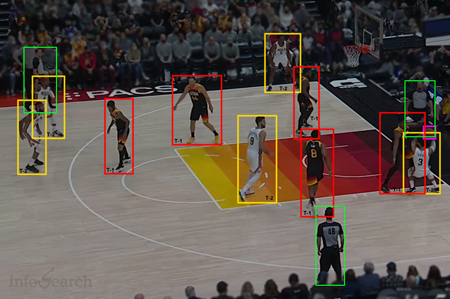"Annotation for Sports Analytics"
Client Profile
The client is a company that provides data analytics services in the field of Ice Hockey, American Football, Soccer, Cricket and Basketball. They use statistical analysis to offer recommendations to the teams, trainers and individual players in the game.

Project Overview
The work of Infosearch BPO Services was to create a player tracking and analysis system that would help its client to gather information concerning sports and their near performance primarily for analysis and presentation. What was wanted was to improve the decision making of the teams by providing impactful intelligence.
The Challenge
The client was struggling with capturing in timely and accurate way value from an immense amount of unstructured big data collected from drones and IoT sensors. The company realized that these data could not be harnessed for a logical and valuable rendition without sufficient annotation. It was observed that in order to strengthen the machine learning models used in their applications there was a dire need for a strong annotation framework.
Objectives:
- Data Collection: Strengthen the tracking of the players in real time over the multiple types of games.
- Performance Analysis: Design ways in which player statistics should be assessed such as speed, flexibility, scoring rate and defense strength.
- Reporting and Visualization: Develop the dashboards and reports so that it is easy for the coaches and analysts who can hardly decipher complex graphics and tables.
- Scalability: Make sure that the system could be expanded for further particular types of sport and for next levels of measure.
Methodology:
Phase 1: Requirements Gathering
- Stakeholder Interviews : Some formal, semi-structured interviews were made to the coaches, analysts and sports scientists to identify specific data requirements.
- Competitor Analysis : Compared with other solutions, the existing solutions in the market have been assessed to determine the spaces for innovation.
Phase 2: System Design
- Architecture : The architectural design was done in such a way that data acquisition, data analysis, and data display accommodated in the design.
- Technology Stack : Choose cloud-based solutions, artificial intelligent based models and data analysis and representation tools (e.g., Amazon Web Services, Python, Tableau).
Phase 3: Data Collection
- Sensor Integration : Partnered with other sport tech firms regarding acquisition of wearable sensors and video tracking technology that can produce correct player data successfully.
- API Development : Designed Application Programming Interfaces used in ingesting data from different sources such as GPS, RFID, and video.
Phase 4: Analysis and Reporting
- Algorithm Development : Designed machine learning models and used them to measure players’ tendencies, compare player’s performance statistics and forecast tendencies.
- Dashboard Creation : Designed compelling dashboards which further helped in real time performance representation and enabled coaches to assess players’ performance easily.
Phase 5: Testing and Iteration
- Pilot Testing : Carried out experimental trials with a couple of squads to gather their feedback to help improve the system.
- User Training : Required to extend efforts to educate the various users regarding adequate usage of the advanced system.
Outcomes:
- Enhanced Performance Insights: Specifically, the client post-implementation survey demonstrated a massive improvement in performance analysis, which helps coaches make decisions based on real-time information.
- Increased Efficiency: Collection and analysis of data were done automatically, therefore cutting the time the analysts used to spend on reporting.
- Scalability Achieved: One key flex feature of the system was that additional sports and metrics could be added as the client evolves.
- User Adoption: The easily understandable dashboards and the relative simplicity of the graphical interface ensured the uptake by the target users, coaches and analysts in this case, thereby optimising the benefit from the generated knowledge.
Conclusion
The transformation of the client’s method in tracking and analyzing the player was evident in the Infosearch BPO Services project. Not only was the project’s maximum goal of helping the team identify appropriate opponents achieved but also the groundwork laid for future research and developments in the field of sports analysis and, more specifically, kinesiological analyses. Teamwork brought about a solution that improved team productivity and decision-making matrix, positioning the client the bundle of services as an industry leader in sports analytics.

